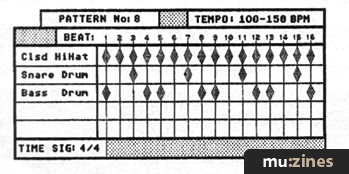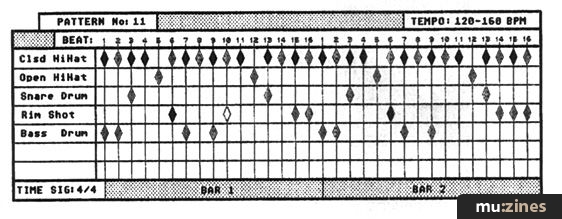Magazine Archive
Home -> Magazines -> Issues -> Articles in this issue -> View
On The Beat (Part 4) | |
Article from Music Technology, November 1989 | |
More experiments with accents form the basis of this episode of Ml's rhythmic soap opera. Nigel Lord beats a path for your drum machine.
THIS MONTH'S EPISODE OF OUR RHYTHMIC SOAP OPERA CONCENTRATES ON FURTHER DEVELOPMENTS OF BASIC GROOVES.
IN PREPARATION FOR this month's rhythmic infusion, I recently spent a happy couple of hours with an Atari drawing package and a hyperactive mouse putting together a few standard beat box grids onto which could be written the patterns for each of the examples. Of course, I am prepared to concede that using dot matrix printouts isn't exactly state of the art in terms of graphic reproduction, but as a means of cutting down the opportunities for mistakes to creep in, the advantages of reprinting the grids as originally written more than outweighs this. And as the patterns grow in sophistication, the likelihood of mistakes occurring becomes a very real problem indeed.
This month, we're again going to be looking at the embellishing of basic grooves, but with the introduction of a third dynamic level and some fairly complex rhythmic figures, we should hopefully be starting to broaden the appeal of this series to include those with an existing knowledge of beat box programming techniques. The three dynamic levels - low, medium and high are indicated by open, dotted and solid diamonds (rhomboids for the tech-heads amongst us), though these will probably be reproduced as varying shades of grey. Now I know there's a danger here of leaving behind those readers equipped with only the most basic machines (particularly those in which dynamics cannot be adjusted for individual instruments), but with certain modifications, there should still be plenty of ideas contained within these examples, which will prove useful on more modest equipment.
As in the last couple of articles, we're again going to be using standard single bar pop/rock patterns as the basis for each example, but we'll be developing these into something more interesting rhythmically, as well as highlighting techniques which may be applied to many 8-,16- & 32-beat patterns.

In its basic form, this month's opening pattern is another of those rhythms to be avoided if at all possible. Though well-structured, it is ultimately quite dull with little or no rhythmic interest (see Pattern 1). The transformation into Pattern 2 produces a much more energetic groove with plenty going on, but still with enough space in which to slot a complementary bassline. It needs to run at a fairly brisk tempo, but should find applications in styles from funk to house with little modification. As with a couple of last month's examples, the crash cymbal at the beginning of Bar 1 is entirely optional, but should always be kept well down in the mix.

Though grossly overused, the basic pattern for the next example has, nevertheless, a quite versatile and powerful feel which may be freely applied to a variety of different song styles. (See Pattern 3)


As is apparent in Pattern 4, however, a little extra programming time and effort can produce much more dramatic results. With its hi-hat line to give it interest and the double bass drum notes to give it power, the pattern, though still conforming to the feel of its rhythmic base, has much more to offer.
Given the complexity of the hi-hat line, you'll need to keep a watchful eye on the tempo - too fast, and it will start to sound unnatural - and as with all complex lines, the dynamics are crucial if the right effect is to be achieved. You'll also need to be careful where the pattern is used - one of the side effects of giving any rhythm more character is a lessening of its range of applications. Having said that, this one could always be used as a fill between other, less distinctive patterns. Incidentally, the rimshot (or side stick) line has been put in brackets to indicate its use as optional. Though it certainly adds a further dimension to the pattern, it does tend to make it even more specialised and therefore less wide ranging in its appeal. Try it and see what you think.

Yet another variation on the standard pop/rock combination, the 16 hi-hat beats to the bar in Pattern 5 help cover the gaps in this fairly sparse bass/snare combination...
The metamorphosis into Pattern 6 produces a much more distinctive groove with a pronounced snare line and neat tom-tom motif at the end of Bar 2. It's not quite so versatile tempo-wise as some of the other examples this month, and seems to work best at around 140bpm. Also, though not particularly dependent on the use of dynamics, the accented snare note at the end of Bar 2 is critical and could even have a rimshot or side stick beat programmed along with it for added effect.

Despite having the same pattern base as the last example, Pattern 7 is a rather more powerful rhythm characterised by rolling tom-tom figures which give its full blooded-feel. Despite this, it still has a broad range of uses provided the accompanying bassline is given sympathetic treatment. A couple of programming notes: if you have a choice of tom-toms, or if tuning is possible on your machine, keep the pitch fairly low for best effect, and don't forget to drop the level of the grace note (or flam) towards the end of the bass drum line in Bar 2.
With an insistent, driving feel to it, Pattern 8 represents a slight departure from the other base patterns this month, but even so is still some way from being memorable.

The addition of a rimshot (side stick) line and the syncopation of the hi-hat soon puts this right, however, and once again we have a highly distinctive rhythm. (See Pattern 9.)
I wouldn't care to slot this pattern into any particular category - the rimshot does give it a slightly Latin tinge - but the relentless bass/snare combination prevent it from becoming locked into that particular genre. In the absence of a rimshot or side stick voice on your machine, you could try substituting a cabasa or even a handclap, but the latter does tend to sound a bit intrusive (and certainly rather dated) and will need to be kept well down in the mix.

Finally this month, we come to a simple but effective rhythm based on Pattern 10. A personal favourite of mine, this one relies almost exclusively for its effectiveness on the accented rimshot on beat 6 of each bar. Don't let its simplicity deceive you; with the right bassline this rhythm can be most compelling. I've used the rimshot as the obvious percussion instrument, but if you have a more hollow-sounding voice available, such as a wood block, then by all means try that - particularly for the trio of notes at the end of Bar 2. (See Pattern 11.)


And that just about winds things up for this month, and (hopefully) for the standard rock and pop rhythmic base.
I'll stress this month, as I have in previous articles, that the examples included, though perfectly usable in their own right, are intended as a spur to (your) further experimentation. At the very least, you could try alternating a pattern with Its rhythmic base and simply adding or deleting notes to gauge their effect on the overall structure of the pattern. Whatever it Is, try to do something to personalise the rhythm to the music for which it Is to act as the foundation.
Next month, things are set to become a bit more involved, so if you've been thinking of trading in your Acme Rhythmpops on something a little more sophisticated this might be a good time to do it.
Series - "On The Beat"
Read the next part in this series:
On The Beat (Part 5)
(MT Dec 89)
All parts in this series:
Part 1 | Part 2 | Part 3 | Part 4 (Viewing) | Part 5 | Part 6 | Part 7 | Part 8 | Part 9 | Part 10 | Part 11 | Part 12 | Part 13 | Part 14 | Part 15 | Part 16 | Part 17 | Part 18 | Part 19 | Part 20 | Part 21 | Part 22 | Part 23 | Part 24 | Part 25 | Part 26 | Part 26 | Part 27 | Part 28 | Part 29 | Part 30 | Part 31 | Part 32 | Part 33 | Part 34 | Part 35
More with this topic
Beat Box |
Off the Wall |
Beat Box |
 Tuning Your Breakbeats |
Steal The Feel (Part 1) |
The Rhythm Method - Beat Box Hits |
Beat Box Ballistics - Drum Machines |
On The Beat - the next generation (Part 1) |
We Can't Go On... (Part 1) |
Beat Box |
Alesis D4 Drum Processing Tricks |
Hands On: Roland TR808 Drum Machine |
Browse by Topic:
Drum Programming
Publisher: Music Technology - Music Maker Publications (UK), Future Publishing.
The current copyright owner/s of this content may differ from the originally published copyright notice.
More details on copyright ownership...
Topic:
Drum Programming
Series:
On The Beat
Part 1 | Part 2 | Part 3 | Part 4 (Viewing) | Part 5 | Part 6 | Part 7 | Part 8 | Part 9 | Part 10 | Part 11 | Part 12 | Part 13 | Part 14 | Part 15 | Part 16 | Part 17 | Part 18 | Part 19 | Part 20 | Part 21 | Part 22 | Part 23 | Part 24 | Part 25 | Part 26 | Part 26 | Part 27 | Part 28 | Part 29 | Part 30 | Part 31 | Part 32 | Part 33 | Part 34 | Part 35
Feature by Nigel Lord
Help Support The Things You Love
mu:zines is the result of thousands of hours of effort, and will require many thousands more going forward to reach our goals of getting all this content online.
If you value this resource, you can support this project - it really helps!
Donations for April 2024
Issues donated this month: 0
New issues that have been donated or scanned for us this month.
Funds donated this month: £7.00
All donations and support are gratefully appreciated - thank you.
Magazines Needed - Can You Help?
Do you have any of these magazine issues?
If so, and you can donate, lend or scan them to help complete our archive, please get in touch via the Contribute page - thanks!


















